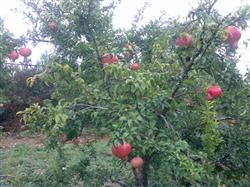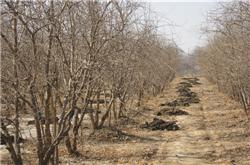Transformation technology of low-yield pomegranate orchard

First, strengthen the management of soil, fertilizer and water in summer. After raking flat, cover the tree plate with 20 cm thick grass or wheat straw, press a small amount of soil on it, and turn it on the spot in the early spring of the following year. From harvest to early winter, the strip ditch method was used to apply base fertilizer, with a depth of 30cm to 35cm, 3000 kg of high-quality farm manure, 3 kg of superphosphate and 2 kg of ternary compound fertilizer. Before the emergence of flower buds, 0.5 kg of diammonium phosphate was applied per plant, and 0.5 kg of peanut cake fertilizer, 2 kg of calcium superphosphate and 2 kg of ternary compound fertilizer were applied per plant during fruit expansion. Water was irrigated before sprouting in spring and after topdressing each time. Second, reasonable shaping and pruning trees are mostly cluster-shaped natural semicircle, and the angles of the main branches are opened 60-70 degrees by means of supporting branches and pulling branches in summer. For the treatment of growing branches and auxiliary branches, adjust the spatial position of the branches. The scraping branches and some leaves near the fruit are cut off during the fruit expansion period. When cutting in winter, the backbone branches and large fruiting branches were retracted to the robust part, and the strong branches were selected to fill the space and the overdense branches were thinned. In the following spring, too many new shoots sprouted by heavy pruning should be erased in time, and dense branches should be removed. Third, pay attention to flower and fruit management. At the early flowering stage, 0.3% potassium dihydrogen phosphate, 300 times urea and 0.3% borax are sprayed every 10 days for a total of 2 times. At the flower bud stage, 2 rings are cut at intervals of 4-10 cm in the middle and lower part of the backbone branches of prosperous trees with few flowers. Timely removal of incomplete flowers and buds, timely removal of combined fruit, late flower fruit, deformed fruit and pest fruit after fruit setting. When the diameter of the fruit is about 2 cm, cover a 25 × 20 cm plastic bag after spraying an insecticide and fungicide, and remove the bag during harvest. 4. the main diseases and insect pests of integrated control include early deciduous leaf disease, black spot, dry rot, apple woolly aphid, Hawthorn spider mite, peach borer, purple velvet scale, mulberry longicorn beetle and so on. Combined with garden cleaning in winter, the shell insects on the branches can be removed with a hard bristle brush, and the trunk should be painted white. From May to June, try not to spray broad-spectrum insecticides to protect and utilize natural enemies. Spray 5 Pomedo stone sulfur mixture before sprouting, spray 5% cypermethrin EC 2000 times to control leaf-eating pests before the rainy season, spray 2 or 3 times of carbendazim suspension at intervals of 10 days after the rainy season to control diseases, and use the poison label method to control trunk borer pests such as mulberry beetles.
- Prev

Key techniques of soil cultivation and management of guava
The application of guava fertilizer should be mainly slow-acting organic fertilizer, supplemented by chemical fertilizer. There is a wide range of organic fertilizers, including plant matter, animal matter and animal waste. Organic fertilizer components are very important, commonly used are rice bran, castor meal, rapeseed meal, soybean powder, peanut meal, waste rice husk, bagasse, waste.
- Next

Planting method of egg yolk fruit
Planting method of egg yolk fruit
Related
- Moge, come on! The staff of the peasant association in the producing area of cantaloupe were frightened when the crowd gathered.
- Causes and Solutions of low Fruit setting rate of Apple
- Symptoms and control measures of passion fruit virus disease
- Fruit growing lesson: how do apple orchards keep high yields?
- Can you build orchards in the mountains? What are the pros and cons?
- How to manage the coloring period of Crisson grape?
- This paper introduces the processing technology of two kinds of fig products.
- How much is a month for retired teachers in rural areas by 2020?
- How can strawberry planting increase sugar content? We should pay attention to management in many aspects.
- What are the cultivation techniques on how to improve the yield of golden fruit?

